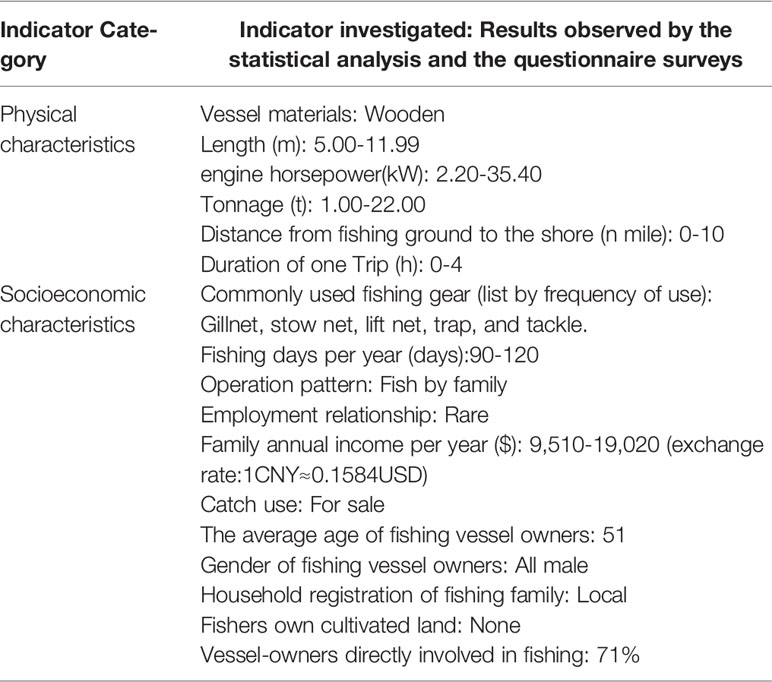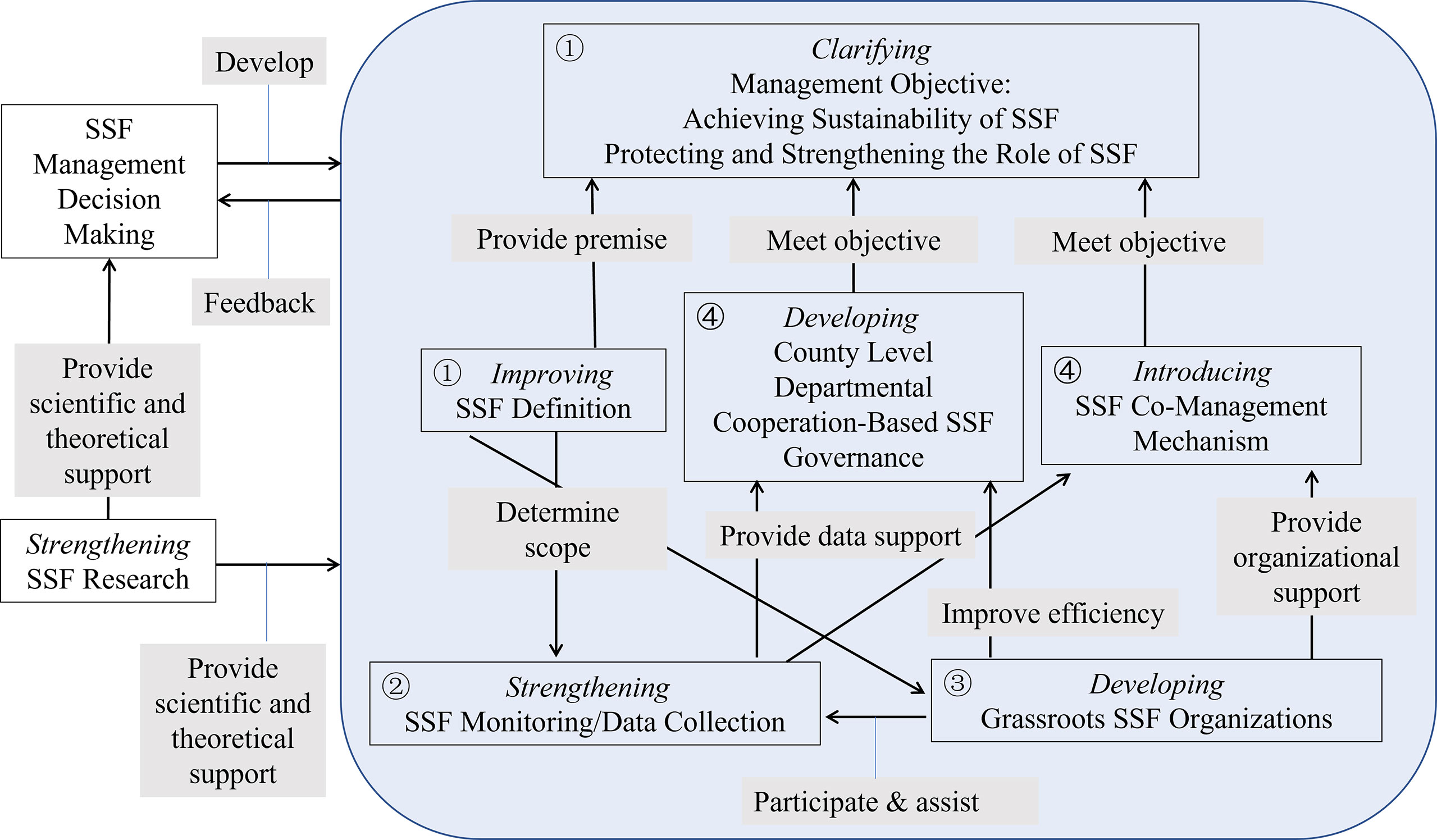- 1College of Marine Culture and Law, Shanghai Ocean University, Shanghai, China
- 2Key Laboratory of the East China Sea and Oceanic Fishery Resources Exploitation, Ministry of Agriculture and Rural Affairs, East China Sea Fisheries Research Institute, Chinese Academy of Fishery Sciences, Shanghai, China
- 3Key Laboratory of Fisheries Remote Sensing Ministry of Agriculture and Rural Affairs, Shanghai, China
- 4College of Foreign Languages, Shanghai Ocean University, Shanghai, China
Small-scale fisheries (SSFs) in China have made incalculable contributions to the supply of aquatic products, employment, and social stability. Despite their importance, aspects such as the complexity, dynamicity, and vulnerability of SSFs are yet to receive sufficient attention either from the Chinese government or from society. Here we help to address the lack of recognition of SSFs by examining their characteristics and possible management solutions. We selected Shengsi County, a community with traditional fishing activities, in Zhejiang Province as a case study to review and examine the SSFs’ characteristics and policies. We aimed to explore the improvement strategies for Chinese SSF management by using data from the open-access government databases, a series of questionnaire surveys and semi-structured interviews, and a collection of national and local SSF-related legislative and policy documents. Here we summarized the physical characteristics of the small-scale fishing vessels and the socioeconomic aspects of SSFs in Shengsi County. Our findings indicate that unprecedented new institutional arrangements for SSFs have been developed in recent years at the national level, and some relevant policies of SSFs also exist at the local level. However, there are still gaps: The concept of SSFs and the goal of their management have not been developed either at the national or local levels; monitoring systems have not yet been established for collecting SSF-related data; fishers engaged in SSFs are still not well organized; cooperation and coordination between different government departments with management authority over SSFs are insufficient; the local government’s response to the central government’s initiatives was slow. Our findings show that the Chinese government could improve SSF management by adopting on an ongoing basis the following suggestions: (1) better define SSFs and set management goals according to their characteristics; (2) develop a monitoring system for SSFs’ data and information collection and promote multidisciplinary research on SSFs; (3) establish SSFs’ cooperatives as soon as possible; and (4) develop coordination and cooperation mechanisms among government departments. This research can provide a reference for the Chinese government to understand SSFs better and contribute to the implementation and improvement of SSFs’ differentiated management in China.
1 Introduction
It is widely acknowledged that small-scale fisheries (SSFs) are critically important in food security, poverty alleviation, equitable development, and fishery sustainability (Kieran et al. 2012; Jentoft, 2014; FAO, 2015; Chuenpagdee, 2018; FAO, 2021). Small-scale fisheries contribute to about half of the global fish catches, with as much as two-thirds destined for direct human consumption (FAO, 2015). In the global sector of capture fisheries, more than 90% of fishers are engaged in the SSFs (FAO, 2015). The Food and Agriculture Organization (FAO) of the United Nations has recognized the importance of SSFs in the 1995 Code of Conduct for Responsible Fisheries (FAO, 1995). Over the past 25 years, countries have raised awareness of the key role SSFs have played in the national economy (Boopendranath, 2012; TBTI, 2016; TBTI, 2018a; TBTI, 2018b; TBTI, 2018c; TBTI, 2018d; FAO, 2021).
The Voluntary Guidelines for Ensuring Sustainable small-scale fisheries in the Context of Security and Poverty Alleviation (abbreviated as SSF-Guidelines) is considered a milestone in strengthening the management of SSFs, which not only includes ensuring food security, eliminating poverty but also emphasizing the significant contribution of SSFs to realizing sustainable development goals. In the 2030 Agenda for Sustainable Development launched by the United Nations, the ocean sub-targets SDG14, Protecting and Sustainable Utilization of Oceans and Marine Resources to Promote Sustainable Development, proposes to provide more chances for SSFs to obtain marine resources and market opportunities (UN, 2015). FAO declared 2022 the International Year of Artisanal Fisheries and Aquaculture, aiming to draw the world’s attention to the critical role of small-scale fishers, fish farmers, and fish workers that could play in food security and nutrition, poverty eradication, and on the urgency of improving their management, with a view to increasing understanding, awareness and action to support them (FAO, 2021).
Although a series of actions have been taken, there are still many challenges in protecting and strengthening the role of SSFs. First and foremost, there is controversy over how to define SSFs, which impedes SSF management in the first place (FAO, 2008; Purcell and Pomeroy, 2015; Rousseau et al., 2019; Smith and Basurto, 2019). SSFs are frequently referred to as distinct from large-scale or industrial fisheries (Thomson, 1980; Halim et al., 2018; Smith and Basurto, 2019). The metrics used to differentiate SSFs from large-scale fisheries or industrial fisheries vary across countries and areas due to their unique resources, political, economic, and cultural situations (FAO, 2008; Purcell and Pomeroy, 2015; Rousseau et al., 2019). Despite the fact that an SSF could be a complicated system, some countries and areas use only a single indicator such as overall length or main engine power of fishing vessel to distinguish SSFs from large-scale or industrial fisheries (FAO, 2008; TBTI, 2018a; TBTI, 2018b; TBTI, 2018c; TBTI, 2018d; Smith and Basurto, 2019). Some scholars have cast doubt on such an approach. Smith and Basurto (2019), for example, advises scientists and practitioners to employ numerous indicators in terms of multiple dimensions to characterize and identify SSF under varied scenarios, which is consistent with the 2014 SSF-Guidelines’ recommendation to define SSFs on a case-by-case basis (Jentoft and Chuenpagdee, 2009; Jentoft, 2014; Chuenpagdee, 2018). Moreover, SSF’s conflicts with large-scale fisheries as well as other related industries have become more severe in recent decades under the combined influence of factors in terms of social, economic, and environmental dimensions, such as globalization, population growth, marketization, climate change, and resource reduction (Gómez et al., 2006; Tzanatos et al., 2006; Said et al., 2017; FAO, 2020; Said et al., 2020; Arthur, 2020). Furthermore, in many parts of the world, small-scale fishing communities continue to face unequal power relations (Israel, 2001; TBTI, 2016; TBTI, 2018a; TBTI, 2018b; TBTI, 2018c; TBTI, 2018d; Berkes, 2021). In this context, it is crucial to clarify the goals of management of SSFs for the government as soon as possible to protect and promote SSFs’ role in food security, poverty alleviation, equitable development, and sustainable fisheries (Andrew et al., 2007; FAO, 2021).
Small-scale fisheries have a long history in China and are one of the country’s oldest, most traditional, and primary types of fisheries (Xu, 1992). As is the case in many other countries, SSFs have not been defined in China’s official documentation (Zhao and Jia, 2020). Nonetheless, it is usually accepted that in China, SSFs include fishing with small-scale vessels and fishing without a vessel. According to China’s Provisions on the Administration of Fishing Licenses 2019 (hereafter referred to as PAFL, 2019) fishing vessels with an overall length of less than 12 m are classified as small-scale1, and the remaining are classified as medium or large-scale (PRC, 2013; PRC, 2019). In 2020,there were over 140,000 registered small-scale marine motorized fishing vessels accounting for 67.25 percent of total marine motorized fishing vessels in China (Fisheries Administration Bureau, 2021). Additionally, there are many non-motorized fishing vessels with a maximum length of under 12 meters. Thus, SSFs are vast in China in terms of fishing fleet size.
In comparison to medium and large-scale vessel fisheries, SSFs rely on older, less competitive, and less risk-resistant fishing equipment, and demonstrate a greater sensitivity to resource, social, and economic changes (Chen and Tang, 2014). However, China’s SSFs have received insufficient attention with people’s lack of knowledge of them contributing to their marginalization (Yang et al., 2011; Ma and Tang, 2019). Management measures customized to SSFs remain scarce; since the 1980s, when China began to strengthen its sustainable fisheries management, a “one-size-fits-all” strategy has been widely used to manage its marine fisheries sector (Su et al., 2020).
This situation has changed greatly since 2017 when China began a new phase of fisheries reform. For the first time since the introduction of the double-control system2 in the early 1990s, the Chinese central government decentralized to provincial governments the authority to develop double-control indicators for small-scale fishing fleets in 2017 (MOA, 2017). Moreover, new rules have been added to the fishing licensing system, including the requirement that fisheries employing small-scale vessels be approved for operation in Class A fishing zone3, that no family may own more than two small-scale fishing vessels, and that fishing without vessels must apply for a fishing license (PAFL, 2019). These institutional reforms heralded the dawn of a new era in China’s SSFs management. To move forward, China must put more effort into closing the gaps in SSFs knowledge and management.
Here, we use a case study from Shengsi, Zhoushan, Zhejiang to investigate the characteristics of Chinese SSFs, explore the flaws in their management, and discuss how to address the flaws. This paper aims to help China’s fisheries institutional reform efforts concerning SSFs, and contribute to a better understanding of Chinese SSFs on a local and global scale. The study’s findings can also be used to inform SSF management reforms in other countries confronting comparable challenges.
2 Materials and Methods
2.1 Study Area
Shengsi County is affiliated with Zhoushan City, Zhejiang Province. It is located in the heart of China’s most productive fishing ground, at the confluence of the Yangtze and Qiantang rivers, as well as the confluence of Taiwan’s warm current and the Yellow River’s cold-water mass. Due to its unique geographical location, the waters of Shengsi are home to a diverse array of fish, shrimp, and crab species many which are economically significant (Su et al., 2018).
The county is comprised of more than 400 islands, all of which are located within China’s Class A fishing area, with Shengshan Island4 serving as China’s easternmost inhabited island (Duan and Zhu, 2016). Today, the majority of China’s island counties are connected to the mainland by sea bridges and are highly commercialized. Their socio-economic development is mostly driven by aquaculture and tourism, with the fishing industry gradually declining in importance. In comparison, Shengsi County has maintained a largely intact fishing industry.
Due to its distance from the mainland, inconvenient transportation, low level of commercialization, and the high proportion of the indigenous5population, Shengsi’s local populations are heavily reliant on fisheries, with many traditional fishing methods still in use today (Su, 2018). In 2005, the State Oceanic Administration approved the establishment of the Shengsi Ma’an Islands National Marine Special Reserve (Figure 1), where many islands and the fishing grounds of SSFs are located.
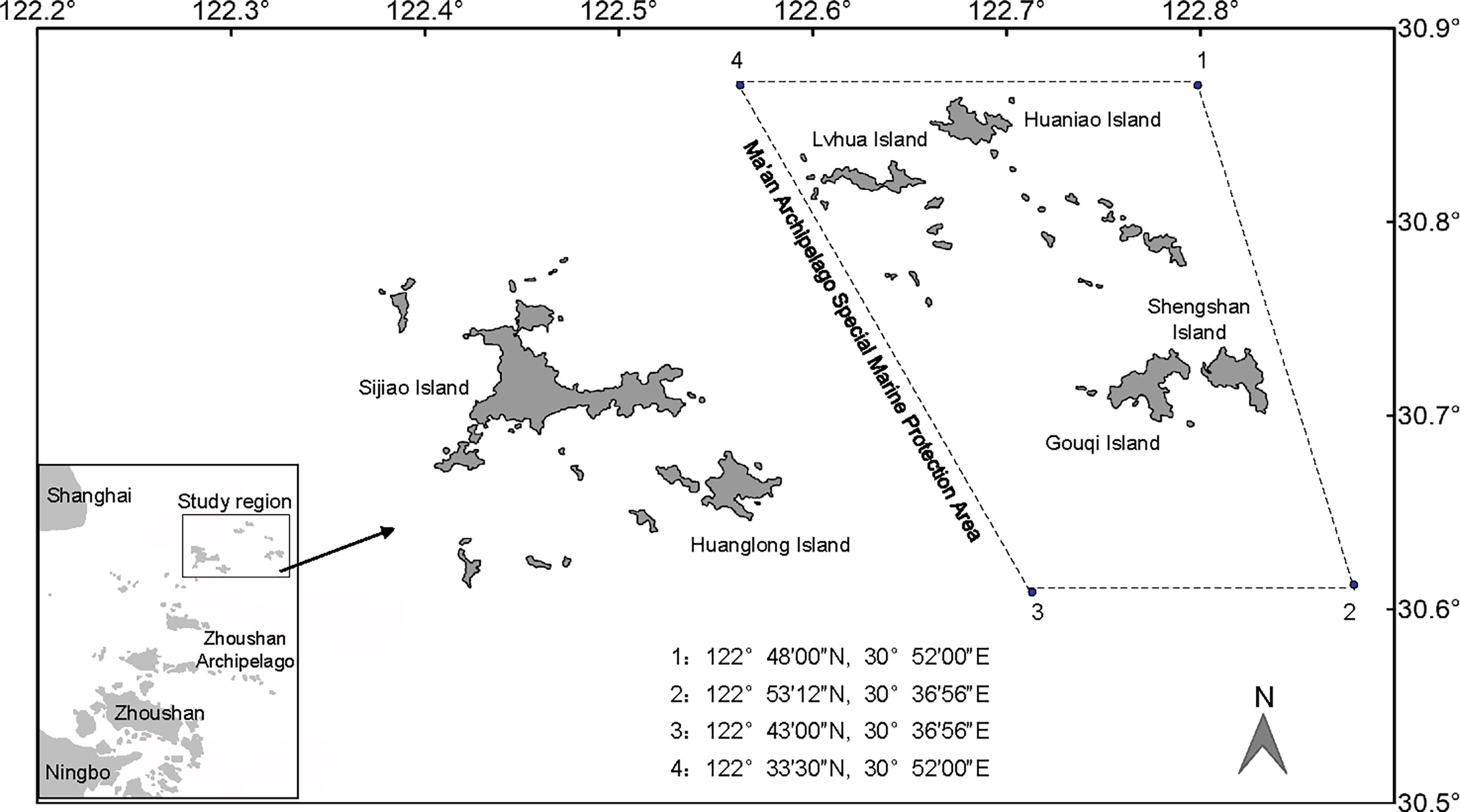
Figure 1 Location of Shengsi and the Ma’an Islands National Marine Special Reserve. Shengsi County is located at the forefront of the Zhoushan fishing ground in Zhejiang Province, including more than 400 large and small islands. Some islands of Shengsi Country and its surrounding waters belong to Ma’an Islands Marine Special Protection Area.
We believe that Shengsi’s management of SSFs is superior to that of the rest of China in terms of research value, owing to the local government’s recent initiatives to tighten SSF management, including the approval of several city and county-level rules and the exploration of a system for distributing fishing rights.
2.2 Methodology
The study employed a mixed approach to explore the characteristics and management deficiencies of the SSFs in Shengsi County. This entailed the following: (1) examined the physical characteristics of the fishing fleet via statistical analysis, (2) investigated the socioeconomic characteristics of the SSFs through questionnaire surveys, and (3) identified management deficiencies through semi-structured interviews and policy documents analysis. The following sections detail the methodologies and data sources used.
2.2.1Description of Fleet Characteristics
The vessel ownership certificates and fishing vessel inspection certificates obtained from the open database of the General Office of the Zhejiang Provincial Government were utilized to gather the raw data necessary to explore the physical characteristics of Shengsi’s SSFs. The raw data were required from the Zhejiang Bureau of Statistics, and we created an own MSC Access database from the raw data and then ran queries. In the first instance, we used the search conditions “main engine power less than 44.1 kW” and “overall length less than 12 m”. A total of 667 results (fishing vessels) were found. In the second instance, we used the search condition “overall length less than 12 m” and a total of 694 fishing vessels were located. Note that although the standard of “main engine power less than 44.1 kW” for defining a small-scale fishing vessel had been removed from the legislation as of 2019, it was still widely utilized as a de facto norm by local law enforcement officers and fishers at the time we conducted this study. As a result of this, and the fact that the results of the two screenings were not substantively different, we decided to use the initial screening results for subsequent analyses.
To characterize the physical characteristics of the fisheries using small-scale fishing vessels, we counted and classified the selected sample (n=667) against six indicators, including the overall length (m), operation type, tonnage (t), engine horsepower (kW), distance from the shore (n mile), trip duration (h).The corresponding results are presented in section 3.1.1.
2.2.2 Questionnaire Surveys
To explore the socio-economic features of the SSFs, we used questionnaire surveys (FAO,1998) and the Convenience Sampling method were undertaken (Battaglia, 2008; Jones et al., 2015; Ruiz et al., 2021). The questionnaire contained 25 questions divided into four sections, including general information, fishing conduct, cost and benefit, and organization (see the Appendix for details). In November 2020 and June 2021, we visited the wharfs and fishing villages on Shengsi County’s key islands, including Huanglong, Gouqi, and Shengshan Island. The questionnaire surveys were conducted following the ethic-related regulations in China.
We invited owners and relatives of small-scale fishing vessels we met at the wharves to participate in our paper-based questionnaires6: We briefed them about the aim of the surveys, the questions that would be asked, and the expected time it would take to complete the questionnaire (i.e., 10-15 minutes). They were reassured that the surveys would be anonymous, that no information about them other than what they provided would be recorded, and that they may choose not to answer any of the questions or decline to participate in the surveys. 113 people agreed to our request and participated in the questionnaires. Because of their limited literacy skills, several participants (n=23) requested that our study team fill out the questionnaire on their behalf using their spoken responses. The remaining participants (n=90) completed the surveys on their own but were accompanied by members of the study team to assist with textual interpretation as needed. Finally, we obtained 113 completed questionnaires, 97 of which were valid and used in subsequent analysis (Section 3.1.2).
2.2.3 Policy Documents Analysis and Semi-Structured Interviews
We reviewed policy documents and conducted semi-structured interviews to identify the flaws in the management of SSFs in Shengsi. Firstly, we combed through all policy and regulatory documents relating to fisheries management in Shengsi, including those issued by the government at national, provincial, city, and county levels; the documents were listed on official websites of the relevant government departments. Secondly, we read the documents and identified key sections that contained information about SSFs; nine documents were found (Table 1A and 1B). We then analyzed the nine documents to identify the key deficiencies concerning SSFs management based on our knowledge and in conjunction with the physical, economic, and social aspects of Shengsi SSFs.
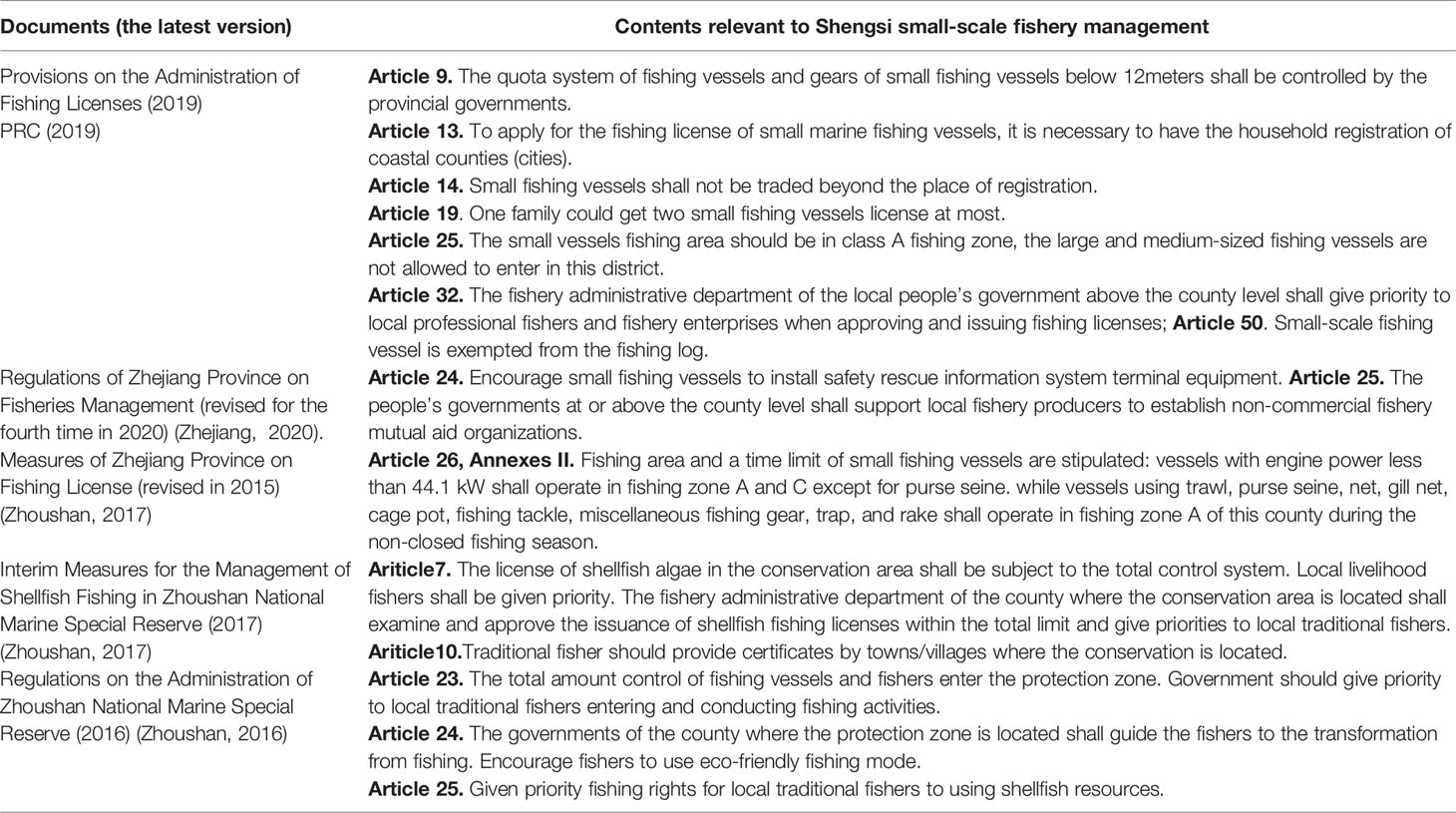
Table 1a Summary of legislative documents relating to current legal system and relevant sections that apply to SSF management in Shengsi County.
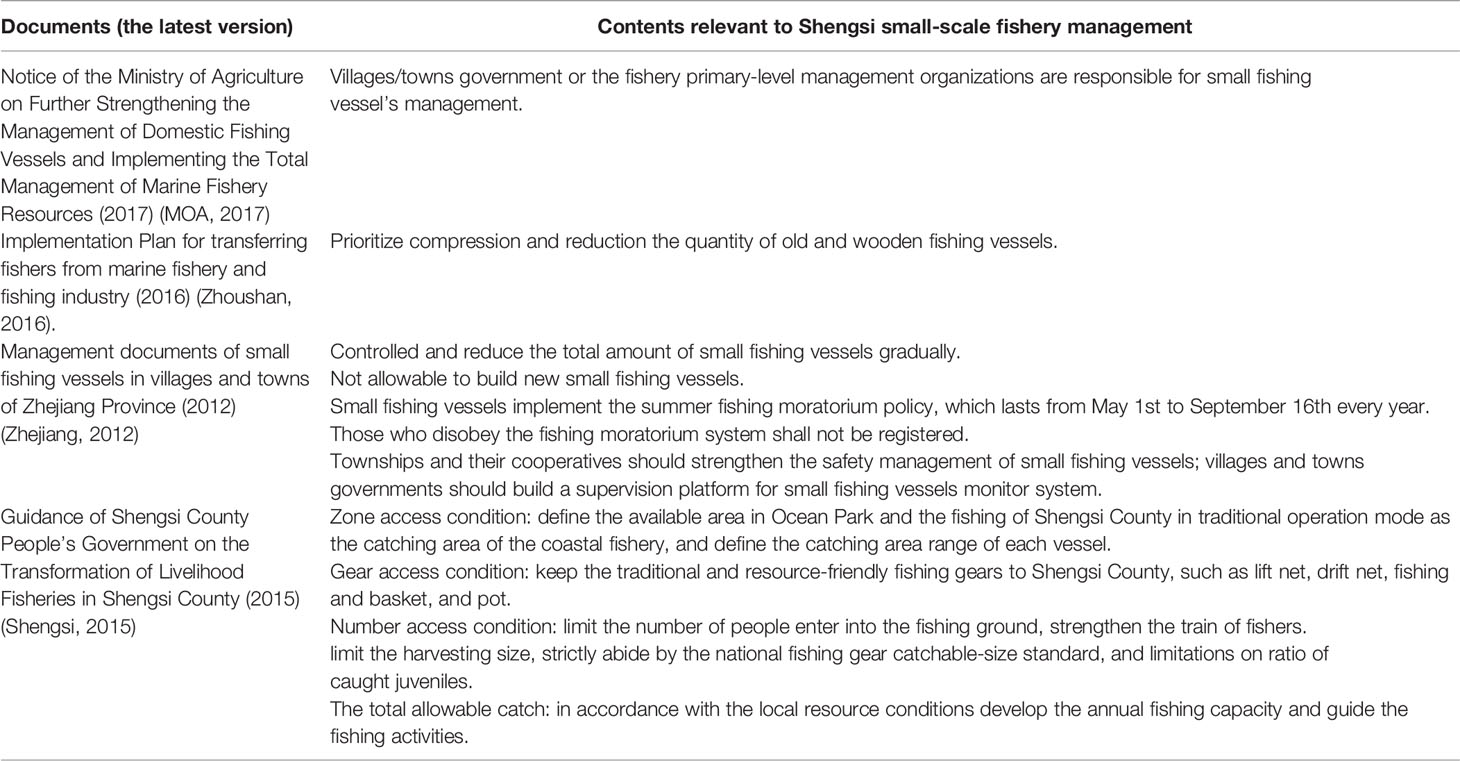
Table 1b Summary of policy documents relating to current legal system and relevant sections that apply to SSF management in Shengsi County.
Subsequently, we conducted semi-structured interviews with key stakeholders to supplement and improve our findings of document analysis. Specifically, we developed 14 questions based on the findings. Afterward, we used the snowball sampling method (Naderifar et al., 2017) to identify key informants, and then assigned them different questions based on their identities (see Table 3 for the questions and their corresponding respondents).
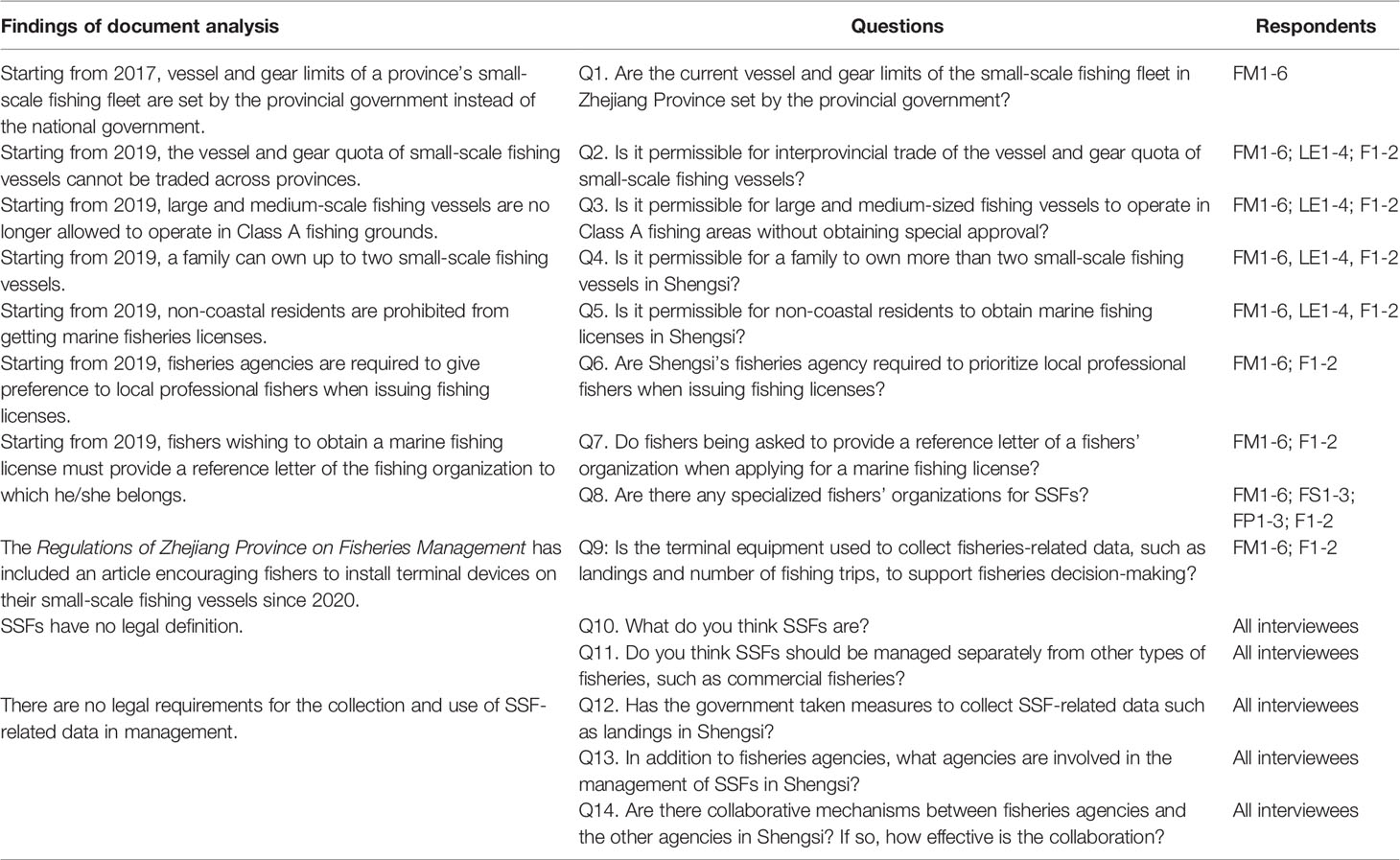
Table 3 Questions developed based on the findings of document analysis for the semi-structured interviews and their corresponding respondents.
A total of 18 stakeholders participated in a face-to-face interview conducted in November 2021. They were six fisheries managers (coded as FM1-6) from the Bureau of Marine and Fisheries of Shengsi Country, four law enforcers (coded as LE1-4) from the law enforcement agency of Shengsi Country, three fish sellers (coded as FS1-3), three fish processors (coded as FP1-3), and two fishers (coded as F1-2). The six fisheries managers recruited for the interviews were recommended and introduced by our contact at the Bureau of Marine and Fisheries of Shengsi Country and had served in Shengsi Marine Fisheries Bureau for more than five years. The remaining 12 interviewees were recommended by and regarded as key informants of Shengsi SSFs by the fisheries managers interviewed (a total of 12 were nominated by the six fisheries managers, and all 12 accepted our invitation to participate in the interviews).
Key information provided by interviewees was written down and verified for accuracy on the spot by the interviewees. All interviews were audio-recorded at the same time. Notably, while no ethics clearance is necessary in China for these types of surveys, all 18 participants were informed of the interview’s content and estimated duration in advance. They were assured that their comments would be treated confidentially and that they would not be identified individually in any report or publication.
3 Results
3.1 SSFs’ Characteristics in Shengsi
3.1.1 Physical Characteristics of Small-Scale Fishing Vessels
The majority (73.7%) of the vessels were wooden and most of the vessels operated with gillnets 53.7% (Figure 2). Although the overall length of an individual fishing vessel varied from 5.00 to 11.99 m, the majority exceeded 11 m (Figure 3). Vessel’s gross tonnage varied from 1.00t to 22.00t and the majority were clustered under 17.00 t, with the most frequent occurrence in the range of 3-3.99 t, followed by 5-5.99 t, and then less than 1.00 t,only two vessels above 17 t (Figure 4). The vessel’s main engine power spanned from 2.20kW to 35.40kW, and the highest frequency was in the interval of 5-9.99kW, followed by 15-19.99kW and 25-29.99kW (Figure 5).
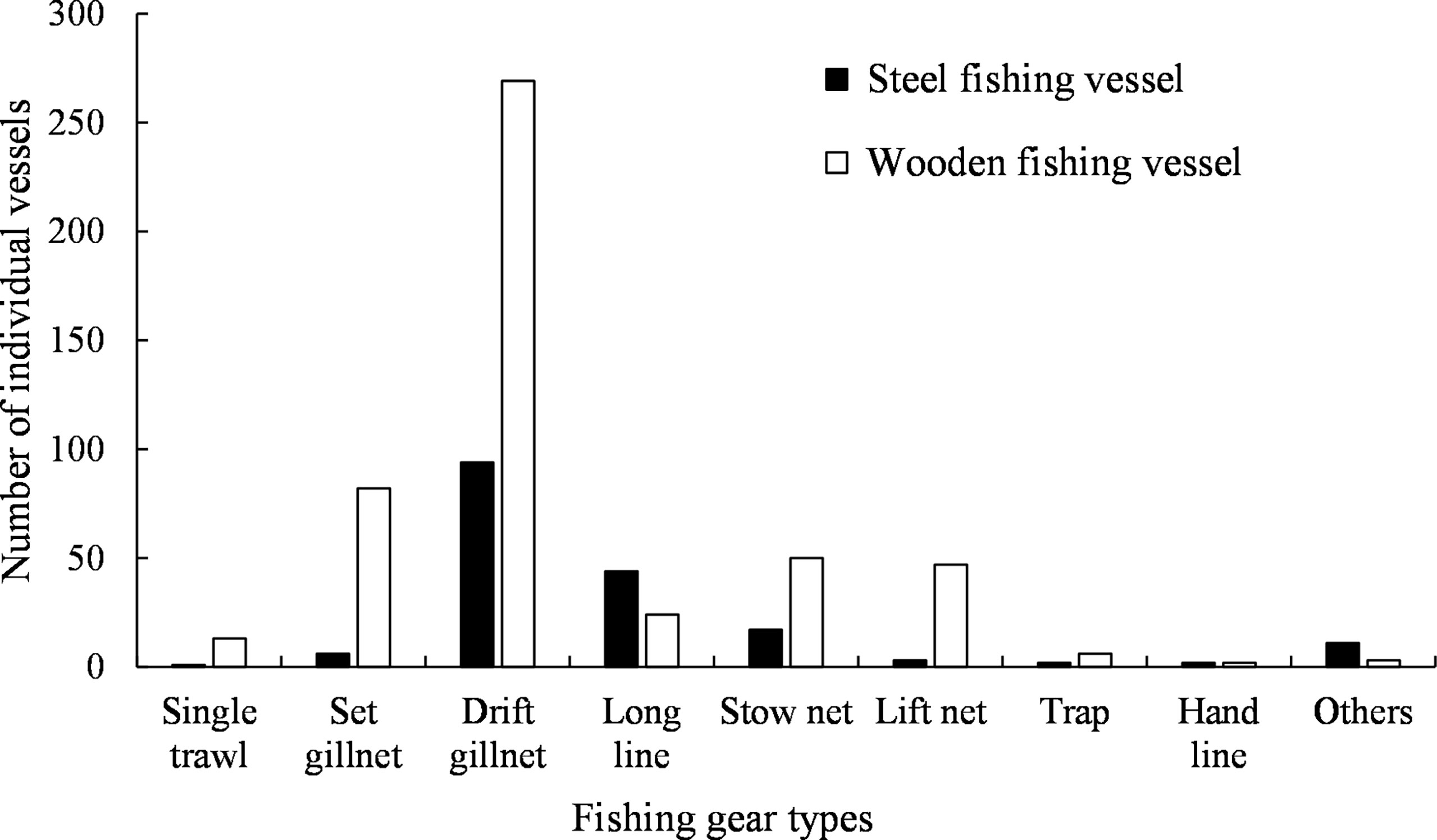
Figure 2 Vessel construction material and gear types of small-scale fisheries in Shengsi County, where black bar represents steel fishing vessels, white bar represents wooden fishing vessels.
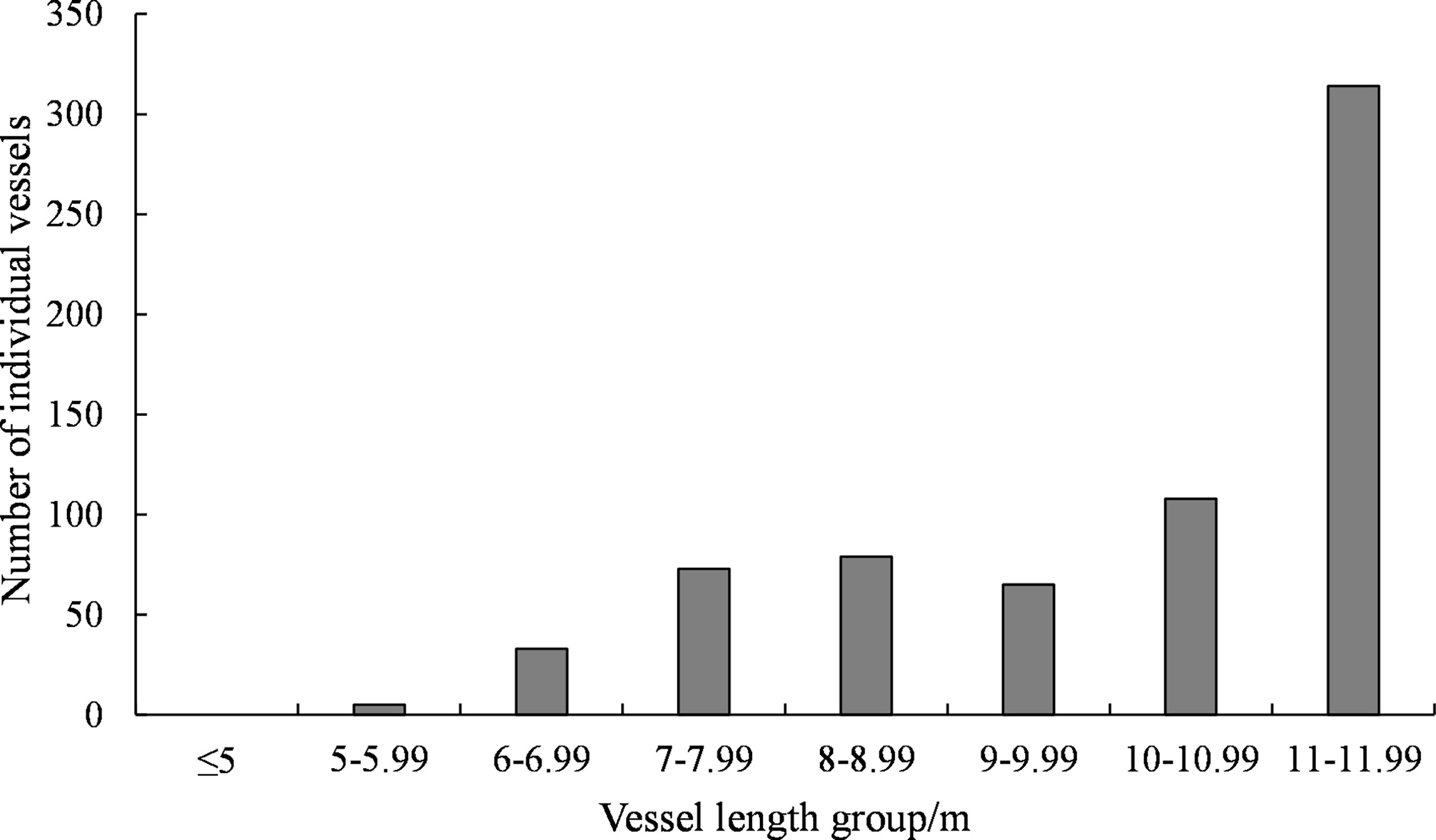
Figure 3 Number of vessels per length category (in meters) for small-scale fisheries in Shengsi Country.
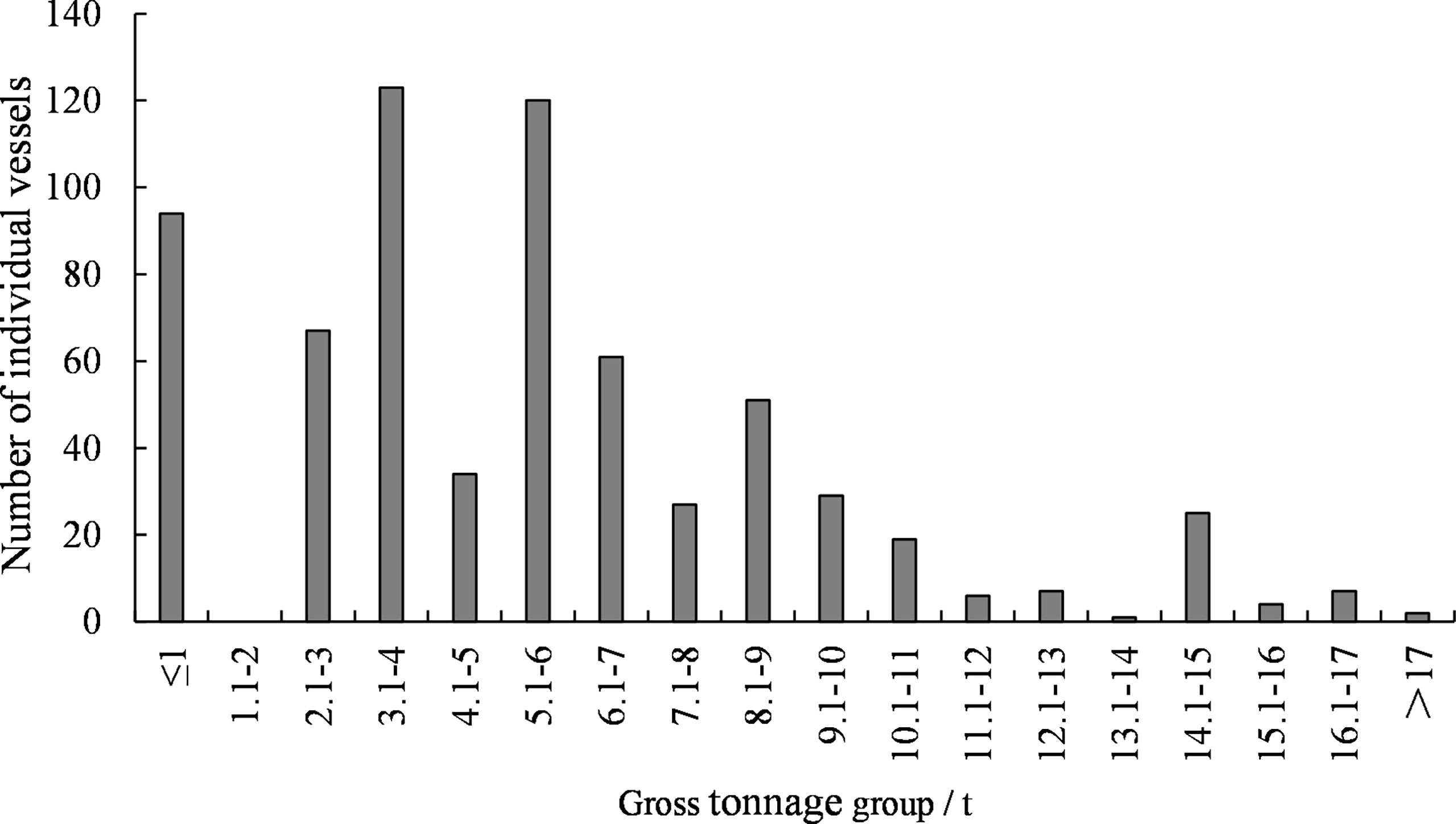
Figure 4 Number of vessels per gross tonnage category (in tons) for small-scale fisheries in Shengsi Country.
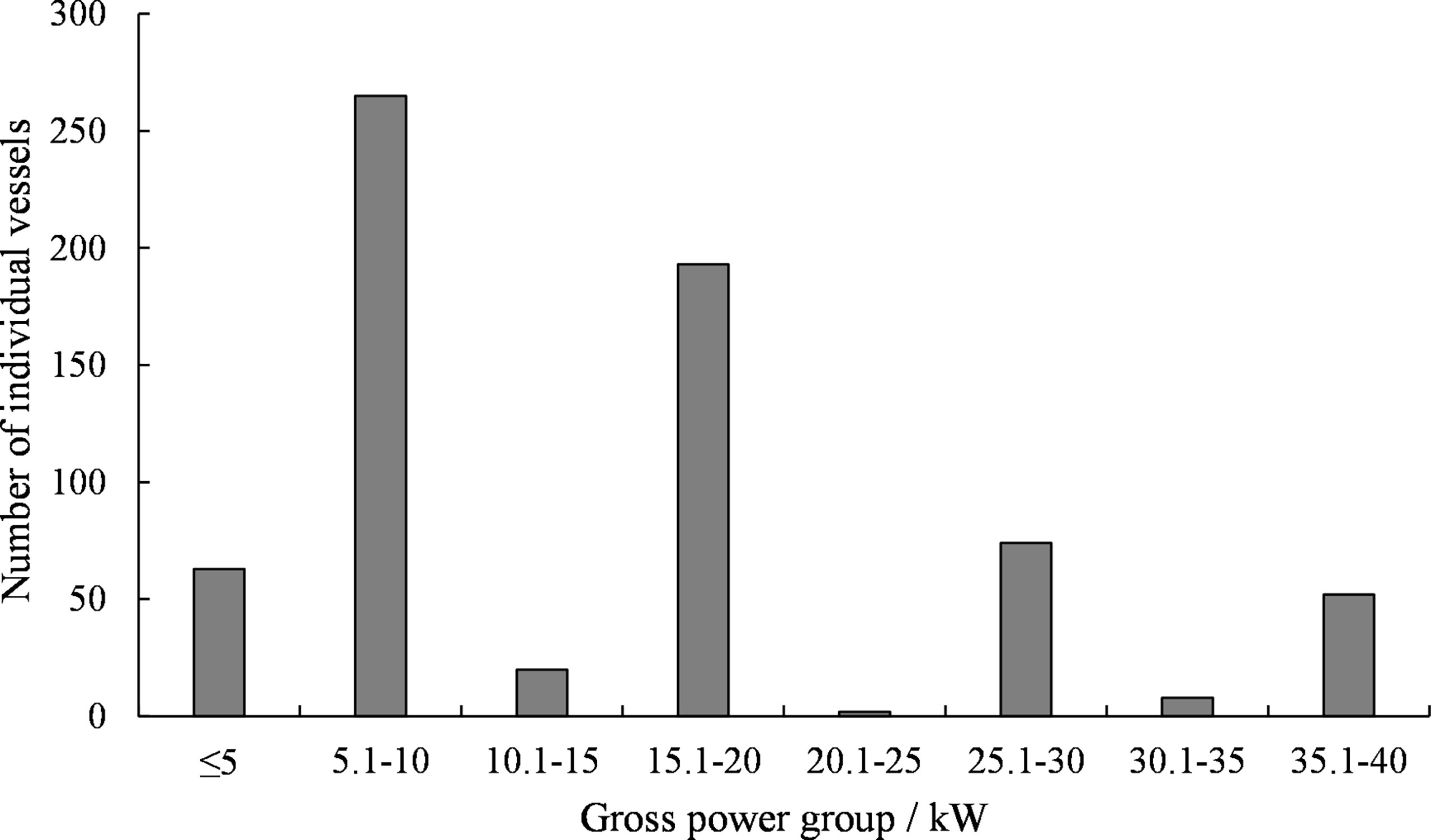
Figure 5 Number of vessels per gross power category(in kW) for small-scale fisheries in Shengsi Country.
There are 470 vessels out of 677 in total with approved navigation area information in their vessel certificates. Navigation area types included sheltered areas not exceeding 5 n miles, coastal areas not exceeding 5 n miles, coastal navigation areas, and sheltered navigation areas (not exceeding 10 nautical miles offshore) (China, 2019). According to the regulations on navigation safety of vessels, the voyage time of small-scale fishing vessels in these approved navigation areas shall not exceed 4 hours.
3.1.2 Socio-Economic Characteristics of SSFs in Shengsi
Table 2 summarized the main findings of the questionnaire surveys. Of all the respondents (n=97), 88 were fishing vessel owners, and they were all males. Most respondents indicated that they engaged in fishing on a family basis, and each family owned only one small-scale fishing vessel. They relied on their own experience and traditional knowledge to fish. In most cases (accounting for 71% of the total), the fishing vessel owner was the only person in the family that directly engaged in fishing operation; their partners were mainly responsible for pre- and post-fishing work, including selling the catch.
Fishers’ annual fishing hours varied by the type of fishing gear they used. Those who engaged in handline fishing operated throughout the year, while those who used stow nets, gillnets, and cages fished from March to April and September to December. On average, each household spent six months each year engaged in the fishing operation. These findings are consistent with the fishing closure’s regulations.
According to the surveys, each family’s annual income ranged between 60,000 and 120,000 Chinese yuan (about 9,500 - 19,000 USD). It appeared that fisheries that using stow nets earned more money than those using other types of fishing gear and that the income was heavily influenced by resource conditions. The main expenses in the fisheries were vessel and net maintenance, as well as fuel usage. Few responses showed employment relationships. In terms of how respondents deal with their catches, it was found that the majority of the catch was sold to fishmongers, traded at the dock, and the remainder were retailed in the market. Furthermore, all of the respondents who identified as vessel owners were indigenous people who lived in fishing villages in Shengsi County. Their family had been fishing for generations and had no cultivated land, but their children’s household registration had been moved away from Shengsi County in most cases.
3.2 Management of SSFs in Shengsi Country
3.2.1 Recent Improvements in the Policy Documents
Since 2017, China has simplified the standards used for defining small-scale fishing vessels and developed customized management regulations for them in various respects. These regulations, according to the PAFL, 2019include the following: (1) each provincial government shall be responsible for setting and issuing vessel and net control indicators for small-scale fishing fleets within their provinces, and the indicators cannot be traded across provinces; (2) to minimize competition that is damaging to SSFs, the fishing grounds of small-scale fishing vessels shall be approved in the Country’s Class A fishing area, while medium and large -scale fishing vessels shall not be permitted to operate in the region; (3) a family can own up to two small-scale fishing vessels and non-coastal residents are prohibited from getting marine fisheries license; and, (4) give preference to local professional fishers when issuing fishing licenses to protect the legitimate rights and interests of local practitioners following the implementation of total capacity control. Further, both the PAFL 2019 and the Ministry of Agriculture’s Notice on Strengthening Control of Domestic Fishing Vessels and Implementing Total Management of Marine Fishery Resources require fishers to join fishery organizations in order to improve the current state of loose fisheries management. All of these improvements demonstrate that China’s central government has recognized the importance of customized management of SSFs.
At the provincial level, Zhejiang Province’s fisheries legislative documents demand the installation of terminal equipment (i.e., vessel monitoring system, VMS)for the safe rescue information system on small fishing vessels and dynamic monitoring of small-small fishing vessels. In addition, the legislation encourages the establishment of fisheries mutual guarantee sorganizations. At the municipal level, the two Zhoushan City legal documents on special marine reserves indicate that SSFs are allowed to operate moderately in the reserves, and appropriate arrangements have been made to ensure the priority access of subsistence fishers to the resources. Furthermore, Shengsi County’s subsistence fisheries-related documents have provided a framework for the protection and management of subsistence fisheries.
3.2.2 Shortcomings in the Management Practice
The PAFL 2019’s new rules on small-scale fishing vessel management and the licensing requirements for fishing without a vessel are unprecedented developments since the People’s Republic of China was founded in 1949. These initiatives demonstrate the Chinese central government’s apparent desire to improve SSFs’ management. According to the interviewees, the above-mentioned newly revised and added regulations in PAFL 2019 had been notified and implemented in Shengsi (also see Q1-7 in Table 3). However, we found that Shengsi SSF management continues to have some significant weaknesses, consisting of the following aspects:
3.2.2.1 Missing Legal Definitions and Tailored Management Systems for SSFs
We found that none of China’s fisheries-related legal documents, from national to county-level, explain what an SSF is and what SSF management entails. The above-mentioned new PAFL 2019 rules are dispersed over several sections of the documents, not to mention that the rules were designed for small-scale fishing vessels rather than SSFs.
In terms of interviewees’ perceptions of “what are SSFs”, six of them stated that fisheries using fishing vessels under 12 m or with main engine power less than 44.1 kW had long been considered SSFs in China in management; the remaining respondents (n=12) stated that they were unsure about the specific definition of SSFs. What’s worth noting is that all the 18 interviewees agreed that using merely vessel length and/or main engine power cannot adequately identify SSFs; they indicated that SSFs shared some common characteristics, such as using vessels less than 12 m, being operated by a small group of people (usually less than three), going on short fishing trips, and close to shore. Additionally, all the interviewees (n=18) agreed that SSFs should be managed separately from commercial fisheries. The fisheries managers and law enforcers interviewed further confirmed that a specific management system for SSFs in Shengsi was not yet established.
3.2.2.2 Missing Requirements on the Collection and Use of SSF-Related Data
Through document analysis, we found that there was no national mandate requiring fisheries with small-scale vessels or without vessels to provide catch logs, nor were there any additional national or local legal requirements on collecting and utilizing SSF-related data in management. According to the interviewees, the government had not yet adopted any approaches to monitoring SSFs in Shengsi County, and the VMS terminal devices installed on some small-scale fishing vessels were not used to collect fisheries production data such as landings to aid decision-making but were solely used to monitor vessel location to help assure safe navigation.
3.2.2.3 Missing Countywide Specialized Fishers’ Organization for SSFs
When applying for fishing licenses, the PAFL 2019 requires fishers to provide a reference letter signed by the fishers’ organization to which they belong, implying that fishers must join an organization. The goal of developing such a rule was to strengthen fisheries communities’ organizational level and to empower the fishing fleet. However, the majority of SSFs in Shengsi were still run on a household basis, and no organization dedicated to SSFs existed at the time the interviews were conducted. According to the interviewees, a fisher would provide a reference letter signed by the village committee or neighborhood committee when seeking a fishing license, and these committees, however, were broad grass-roots autonomous groups comprised of residents. That is, they were not specialized fishers’ organizations and did not contribute to the sector’s organizational development.
3.2.2.4 Insufficient Cross-Departmental Coordination for SSF Governance
Interviewees widely recognized that although the fisheries agency was primarily responsible for SSF management, there were other departments involved, including those in charge of marine, financial, civil, human, and social affairs, public security, border defense, health, education, and housing development. Our document analysis, however, revealed that no cross-departmental coordination mechanism had yet been developed between the fisheries agency and these departments. The importance of coordination across departments for successful SSF management was emphasized by the 10 interviewees (i.e., FM1-6 and LF1-4). They noted that such coordination appeared to be challenging because the administrative functions of the departments somewhat overlapped and their administrative objectives were diverse and occasionally conflicting. Another finding, according to one interviewee (FM2), was that while the fisheries and marine agencies, the two most important authorities dealing with SSFs, were internal divisions of the same department at the county and city levels7, they were two separate departments at the province level8. This inconsistency in organizational structure hampered departmental coordination even further.
3.2.2.5 Local Governments’ Policy Lagging Behind the National Agenda
The PAFL 2019 with new rules concerning SSFs has been enforced for three years. However, the policy documents governing SSFs in Zhejiang Province, Zhoushan City, and Shengsi County were largely enacted before 2019 and were not updated to reflect the changed or newly added provisions of PAFL 2019. The gap between national and local legal documents indicates, to some extent, that the SSFs management in Shengsi was lagging behind the national agenda9.
4 Discussion: How to Improve SSFs Management in China?
We found that the management of the SSFs in Shengsi still has a lot of space for improvement based on the results of the policy analysis and the opinions of stakeholders. While modifications made to national fisheries legal texts have the potential to improve SSF management, these documents continue to have shortcomings. There is still no precise definition of SSFs, and there is no legal requirement for data collection and usage in SSF management. Meanwhile, there are flaws in the organizational structure and division of responsibilities. Additionally, local governments’ response to the change of national-level policy has been slow. The Ministry of Agriculture and Rural Affairs issued China’s 14th Five-Year Plan for Fisheries Development 2021-2025 in January 2022, stating that the next stage of China’s marine fisheries management will focus on “optimizing the structure of the fishing industry” instead of the previous ”strict control (over total fishing capacity).” This shift in focus mirrors China’s fisheries management’s movement toward distinction, refinement, and science, which presents new opportunities for improving SSF management. In this regard, we propose to focus efforts in the following areas to strengthen SSF management in China. Figure 6 presents a schematic to illustrate the strategy we proposed to improve SSF management, including the different spheres of management and their interactions.
4.1 Defining SSFs Based on Their Characteristics and Clarifying Management Objectives
Defining SSFs is an important base for the precise governance of SSFs (Jentoft, 2014; Chuenpagdee, 2018; Halim et al., 2018; Smith and Basurto, 2019). China is a county whose fisheries management relies on a largely homogenous and top-down system (Zhao and Jia, 2020). However, ‘China has a vast coastline, a large number of fishing vessels, and a complex structure of the fishery industry ‘ (Huang and Tang, 2019), universally defining SSFs throughout the nation can be hard due to the very diverse characteristics of SSFs in different regions of the country. In this case, according to the available data sources of SSFs and the existing regulations, we propose that China could develop a set of basic indicators for identifying SSFs at the national level, and then allow the local government to add customized socio-economic indicators and determine the specific values of the basic and customized indicators to define the SSFs under its jurisdiction according to the local situation. The basic indicators could include the type and size (including fishing without vessels) of a fishing vessel, the spatial scope and type of fishing, and the number of fishing vessels owned by the owner.
Quantitative characteristics are generally straightforward to ascertain, whereas qualitative characteristics are highly variable and difficult to ascertain due to their high degree of integration with political, economic, cultural, and other aspects (FAO, 2005; Johnson, 2006; Jentoft, 2014; Su, 2018; Robotham et al., 2019; Smith and Basurto, 2019). We propose to use a combination of the quantitative and qualitative features of the fisheries to determine SSFs. Quantitative indicators include the type and size of a fishing vessel and the area of the fishing ground; qualitative indicators include the type and size of fishing gear, fishery output units, income levels, and catch utilization patterns. Additionally, the household registration system, cultivated land ownership via, and whether the vessel owners are directly participating in fishing could be used as qualitative markers to distinguish SSFs from other fisheries.
It is critical to define management objectives in order to ensure successful governance (Guyader et al., 2013; García-Flórez et al., 2014; Halim et al., 2018). We propose developing a set of SSF-specific management objectives. Such objectives could include safeguarding SSF practitioners who rely on fisheries for their living when fishing capacity is reduced, prioritizing SSFs practitioners when allocating fishing opportunities, and maintaining SSFs fishing grounds.
4.2 Strengthening Data Collection in SSFs
The data serve as the foundation for science-based fisheries management (Costello et al., 2012., EDF, 2013., Su et al., 2021). Data scarcity is a global, long-term issue that impedes the management and protection of SSFs worldwide (Thorpe and McGoodwin, 1996; Zeller et al, 2007; Guyader et al., 2013; García-Flórez et al., 2014; Zeller et al., 2014; Chuenpagdee and Jentoft, 2018). Due to the distinct characteristics of SSFs and industrial fisheries, data gathering in SSFs is significantly more difficult than that of industrial fisheries (FAO and World Fish Center, 2008; Kieran et al, 2012; Nguyen et al., 2017; FAO, 2017; EDF, 2018). Lack of data gathering of SSFs in China is the primary cause of the data and knowledge gap in its SSFs, which makes the implementation of science-based fisheries decision-making even more difficult.
Here, we offer the following approaches for improving data gathering of SSFs in China based on the findings of this study. To begin, in terms of fishing operation data, rather than requiring individual fishers to complete fishing logs, we propose developing an organization-based fishing operation reporting system. To do this, the government must foster the formation of small-scale fisher’s organizations and then allow the organizations to act as a conduit between the vast number of SSF fishers and the local government. In detail, SSF members would be expected to submit data to the organizations to which they belong. After each fishing trip, the species of catch, the quantity caught, the operation location, and the date of the trip can be reported. Monthly, quarterly, and annual reports can be made on the physical characteristics of fishing vessels and gear, as well as on employment, income, cost, landings and their composition.
The small-scale fishers’ organizations may be responsible for developing, maintaining, and updating SSF databases. The government and the organizations might collaborate to develop a simple-to-use mobile fishing log APP or to assist fishers in installing video monitoring equipment on eligible fishing vessels if finance allows (Fréon et al., 2014; Fujita R et al., 2018; Aura et al., 2019).
4.3 Accelerating the Construction of GrassRoots SSF Fishers’ Organizations and Introducing a Co-Management Mechanism
Organizations are crucial to improving the management of SSFs (Castilla and Fernandez, 1998; Pomeroy et al., 2001; Linke and Bruckmeier, 2015; Jentoft and Chuenpagdee, 2015; Chambers and Carothers, 2017; Berkes, 2021). To promote China’s SSF management, we propose that the government assists SSF fishers in coastal communities who share common interests in organizing, and then provides institutional and financial support to the organizations. To ensure that an organization’s members are cohesive and capable of sharing and acquiring common information, experience, production, and technology, the established organizations could be categorized according to population size, fishing type, and employment type (e.g., fishing, processing, and sale). We recommend that the organizations be accountable for organizing the fishing gear, labor, and capital in an integrated fashion. This technique will benefit not only in terms of decreasing individual operation costs but also in terms of sensible resource allocation and use. Additionally, it will help save management costs, increases the effectiveness of policy execution, and strengthens fishers’ sense of belonging and their social responsibility and value.
In fact, several countries, like Japan, South Korea, the United States, and Chile, have substantial experience operating SSFs on an organizational level (Castilla and Fernandez, 1998; Defeo and Castilla, 2005; Song, 2015; Defeo et al, 2014; Delaney, 2015; Lee and Rahimi Midani, 2015; Su, 2018; Tsurita et al., 2018; Alyne, 2018). Furthermore, the benefit of the co-management approach used in SSFs in facilitating collaboration between stakeholders, including Producer Organizations (Pos), the government, and markets, in France has been recognized (Pascual-Fernandez J, 2020; Jentoft, 2005; Jentoft, 2007). Among the stakeholders, the Pos serves a vital role in SSF management by formulating regional fisheries management plans and allocating quotas to the organizations’ members (Pascual-Fernandez J, 2020). These practices suggest that the co-management model is highly worth investigating.
4.4 Establishing a Departmental Cooperation-Based Governance Model for SSFs
Collaboration across many government departments is necessary to ensure that SSFs management meets its output targets (Léopold et al., 2013; Purcell and Pomeroy, 2015; Chuenpagdee, 2018). We urge the agencies with responsibilities for managing SSFs to address the issue of insufficient inter-departmental coordination as soon as possible. We recommend that county governments build an inter-departmental collaboration mechanism and information exchange platform for SSF management. The mechanism and the platform should be developed to handle existing challenges such as functional overlap among departments. We underline here that interdepartmental collaboration should anticipate management issues and develop plans to mitigate opposition and implementation costs, ultimately resulting in the formation of a departmental cooperation-based governance model. Furthermore, mechanisms for addressing concerns across administrative levels and regions are needed.
4.5 Strengthen Research on Small-Scale Fisheries
At the moment, research on China’s SSFs is insufficient. Most of the earlier research on this subject conducted by Chinese scholars concentrated on the conceptual analysis of SSFs or providing an introduction to SSFs administration in other countries. Inadequate scientific studies have contributed to China’s knowledge gap regarding SSFs and have hampered science-based decision-making when regulating SSFs. As a result, we call for increased data collection and research on SSFs. The research should be multidisciplinary, covering aspects including fisheries, resources, environment, society, economy, humanities, and politics.
5 Conclusions
The critical role and management of SSFs have garnered broad international attention. In China, this issue is gaining unprecedented attention. In 2020, there were more than140,000 small-scale registered marine motorized fishing vessels, (Zhao and Jia, 2020). China’s domestic marine fishing output will account for 87% of total domestic fishery output in 2020 (Fisheries Administration Bureau, 2021);fishers who engaged in fishing for not less than six months with their net income from fisheries accounted for 50% of the total household income accounted for 54% of all people engaged in fishing (Fisheries Administration Bureau, 2021). The catch of SSFs consisted of more than 100 fish stocks from at least 32 types of fishing gears and methods (Zhao and Jia, 2020). China’s coastline is extensive, and its fishing industry is vast with a very complex structure. The SSFs in different parts of the Country’s coastal areas varies significantly. Through a case study of SSFs in Shengsi County, we analyzed the characteristics and management policies of SSFs in a specific locality and puts forward suggestions for improving the management of SSFs in China.
In terms of SSF management, the PAFL 2019 indicates that the standard for defining small-scale fishing vessels has been simplified the overall length of the vessel is now the sole indicator, and the main engine power is no longer employed. Also, China has built new institutional arrangements at the national level for the management of SSFs. These arrangements address the development and assignment of the small fishing vessel and net indicators, the distribution of fishing grounds, and the application of fishing licenses. Along with legislative changes at the national level, Zhejiang Province has strengthened vessel location monitoring, mutual assistance, and dynamic supervision of small-scale fishing vessel fisheries. Zhoushan City allows SSFs to operate on a modest level within the special marine protected area and prioritizes fishing chances for subsistence fishers. Additionally, Shengsi County has established a policy framework to promote and protect subsistence fisheries. Despite the fact that there are initiatives in place, the management of SSFs in Shengsi continues to have serious flaws, including the following: (1) neither the concept of SSFs nor its management objectives are clearly defined in national nor local legal documents; (2) small-scale fishing vessels and fishing without vessel are not required to submit fishing logs, and there are no other relevant legal requirements for the collection and use of SSFs data in management; (3) small-scale fishers’ organizations have not been established, and (4) coordination between government departments on SSF management is insufficient. Furthermore, our document analysis revealed that there were regulatory gaps in SSF management requirements between national and local legal documents. This reflects the local governments’ slowness in responding to national policy.
By and large, given the critical role of SSFs in ensuring the sustainability of China’s fisheries and the socio-economic development of coastal fishing communities, we urge that the Chinese government work to advance SSF management on an ongoing basis. We propose that the government incorporates a standard into legal documents that allow defining SSFs on a case-by-case basis.Meanwhile,the government should clarify SSF’s management objectives, strengthen data collection and multidisciplinary research on SSFs, promote science-based decision-making, and establish an interdepartmental coordination and cooperation mechanism for SSF management.
Data Availability Statement
The original contributions presented in the study are included in the article/Supplementary Material. Further inquiries can be directed to the corresponding author.
Ethics Statement
Questionnaire surveys and interviews in this study were conducted in compliance with Chinese laws and with the consent of the respondents. All participants were aware of the use of the data obtained from the surveys and were over 18 years old.
Author Contributions
MX: Conceptualization, data collection and resources analysis, investigation, writing-original draft, writing-reviewing and editing, restructure of the manuscript and its revision to address the reviewers' comments. ZW: Conceptualization, data collection and analysis, investigation. YT (corresponding author): Conceptualization, supervision, provision of study resources, reviewing and modification, restructure of the manuscript and its revision to address the reviewers' comments, funding acquisition. SS: restructure of the manuscript and its revision to address the reviewers' comments. HS: Writing-reviewing.
Funding
This study was supported by the fund of the Ministry of Agriculture and Rural Affairs: The Construction of fisheries resources use right system and its relationship with other fisheries management systems.
Conflict of Interest
The authors declare that the research was conducted in the absence of any commercial or financial relationships that could be construed as a potential conflict of interest.
Publisher’s Note
All claims expressed in this article are solely those of the authors and do not necessarily represent those of their affiliated organizations, or those of the publisher, the editors and the reviewers. Any product that may be evaluated in this article, or claim that may be made by its manufacturer, is not guaranteed or endorsed by the publisher.
Acknowledgments
We thank all the participants for sharing their time, knowledge and experience. We are grateful two anonymous reviewers for constructive comments.
Supplementary Material
The Supplementary Material for this article can be found online at: https://www.frontiersin.org/articles/10.3389/fmars.2022.811382/full#supplementary-material
Footnotes
- ^ Prior to 2017, China’s small-scale fishing vessels were defined as fishing vessels with a main engine power of less than 44.1 kw and an overall length smaller than 12 m.
- ^ The double control system is an input control method aimed at reducing or limiting the total fishing capacity of a fishing fleet through controlling overall vessel number and horsepower of fishing fleet (i.e., control indicators).
- ^ According to Article 23 of the Regulations on Provisions on the Administration of Fishing Licenses 2019, the marine fishing zone is divided into four categories: A,B,C,D. Class A includes the sea area of the Yellow Sea, Bohai Sea, East China Sea, South China Sea, and other sea areas on the land side of the outer boundary of closed fishing zone for bottom trawling by motorboat; Class B are Chinese and surrounding countries jointly managed fishing areas, which including Nansha sea area, Huangyan Island sea area and other specific fishery resources fishing grounds and aquatic germplasm conservation zone; Class C including the Bohai Sea, Yellow Sea, East China Sea, South China Sea and other sea areas under China's jurisdiction except Class A and Class B fishing zones. Class D fishing area is high seas.
- ^ Shengshan is an island town in Shengsi County.
- ^ Persons born in Shengsi who speak the local dialect.
- ^ To ensure that the sample was representative and not influenced by our subjectivity, we invited as many fishers and their relatives running small-scale fishing vessels we met at the wharves as possible.
- ^ At City and county levels: Bureau of Marine and Fisheries of Zhoushan City; Bureau of Marine and Fisheries of Shengsi County.
- ^ At provincial level: Department of natural resources of Zhejiang Province; Department of Agriculture and Rural Affairs of Zhejiang Province.
- ^ This issue makes assessing the impact of legislative changes at the national level on local SSFs impossible and futile at this time, despite the fact that such a topic deserves to be addressed.
References
Andrew N. L., Béné C., Hall S. J., Allison E. H., Heck S., Ratner B. D. (2007). Diagnosis and Management of Small-Scale Fisheries in Developing Countries. Fish Fish 8, 227–240. doi: 10.1111/j.1467-2679.2007.00252.x
Arthur R. I. (2020). Small-Scale Fisheries Management and the Problem of Open Access. Mar. Policy, 1–5. doi: 10.1016/j.marpol.2020.103867
Aura C. M., Nyamweya C. S., Njiru J. M., Odoli C., Musa S., Ogari Z., et al. (2019). Using Fish Landing Sites and Markets Information Towards Quantification of the Blue Economy to Enhance Fisheries Management. Fisheries manag Ecol. 26, 141–152. doi: 10.1111/fme.12334
Guidance of Shengsi County People’s Government on the Transformation of Livelihood Fisheries in Shengsi County (2015) (Shengsi: Shengsi government). Available at: http://www.shengsi.gov.cn/art/2015/8/26/art_1229561936_1638444.html.
Standing Committee of Zhejiang Provincial People’s Congress.Measures of Zhejiang Province on Fishing License (Zhejiang: Standing Committee of People’s Congress). (2015) Available at: https://www.zj.gov.cn/art/2021/7/16/art_1229017137.
Too Big to Ignore, Global Partnership for Small-Scale Fisheries Research. Available at: http://toobigtoignore.net/about-tbti/,2013-12-30.
Battaglia P. M. (2008). “Nonprobability Sampling,” in Encyclopedia of Survey Research Methods. Ed. Lavrakas P. J. (Thousand Oaks: SAGE Publications), 6–7. doi: 10.4135/9781412963947.n337
Berkes F. (2021). Co-Management and Social Learning. Toward a New Social Contract: Community-Based Resource Management and Small-Scale Fisheries. Fikret Berkes(TBTI Global), 152–167. Abailable at: http://toobigtoignore.net/toward-a-newsocial-contract-by-fikret-berkes/
Boopendranath M. R. (2012). “FAO Code of Conduct for Responsible Fishing Operations,” in Fish Harvesting Systems for Resource Conservation. Eds. Thomas S. N., Edwin L., Pravin P., Remesan M. P., Ashraf P. M., Baiju M., Madhu V. R. (Cochin: Central Institute of Fisheries Technology), 74–77.
Castilla J. C., Fernandez M. (1998). Small-Scale Benthic Fisheries in Chile: On Co-Management and Sustainable Use of Benthic Invertebrates. Ecol.Appl. 8, 124–132. doi: 10.1890/1051-0761(1998)8[S124:SBFICO]2.0.CO;2
Chambers C., Carothers C. (2017). Thirty Years After Privatization: A Survey of Icelandic Small Boat. Fishers. Mar. Policy 80, 69–80. doi: 10.1016/j.marpol.2016.02.026
Chen Y. Y., Tang Y. (2014). Study on Co-Management of China’s Small-Scale Fisheries Based on Fisher’s Organization. Guangdong Agric. Sci. 6, 221–225. doi: 10.16768/j.issn.1004-874x.2014.06.050
China M. S. A. (2019). Technical Rules for Legal Inspection of Small Marine Fishing Vessels in (China. (Beijing: Maritime Safety Administration of the people’s republic of China).
Chuenpagdee R. (2018). Too Big to Fail: An Essay About Svein Jentoft’s Engagement in Small-Scale Fisheries Research and Development of the Interactive Governance Theory. Maritime Stud. 17, 305–314. doi: 10.1007/s40152-018-0114-8
Chuenpagdee R., Jentoft S. (2018). Transforming the Governance of Small-Scale Fisheries. Maritime Stud. 17, 101–115. doi: 10.1007/s40152-018-0087-7
Costello C., Ovando D., Hilborn R., Gaines S. D., Deschenes O., Lester S. E. (2012). Status and Solutions for the World’s Unassessed Fisheries. Science 338 (6106), 517–520. doi: 10.1126/science.1223389
Defeo O., Castilla J. C. (2005). More Than One Bag for the World Fishery Crisis and Keys for Co-Management Successes in Selected Artisanal Latin American Shellfisheries. Rev. Fish Biol. Fisher 15 (3), 265–283. doi: 10.1007/s11160-005-4865-0
Defeo O., Castrejón M., Pérez-Castañeda R., Castilla J. C., Gutiérrez N. L., Essington T. E., et al. (2014). Co-Management in Latin American Small-Scale Shellfisheries: Assessment From Long-Term Case Studies. Fish Fish 17, 176–192. doi: 10.1111/faf.12101
Delaney A. E. (2015). “Japanese Fishing Cooperative Associations: Governance in an Era of Consolidation. Interactive Governance for Small-Scale Fisheries,” in Interactive Governance for Small-Scale Fisheries: Global Reflections, Svein Jentoft and Ratana Chuenpagdee (Switzerland: Springer International Publishing), 263–277.
Duan X. C., Zhu X. H. (2016). Researches on Salt Water Fishing Tourism-Taking Shengshan Island in Zhoushan as an Example. Territory Natural Resour. Stud. 2016, 89–91.
Apel A. M., Fujita R., Karr K. (2013s). Science-Based Management of Data-Limited Fisheries: A Supplement to the Catch Share Design Manual. (New York:Environmental Defense Fund).
FAO (1995). Code of Conduct for Responsible Fisheries (Rome: FAO). Available at: https://www.fao.org/3/v9878e/v9878e00.htm.
FAO (2005). Interdisciplinary Approaches to the Assessment of Small-Scale Fisheries (Rome: FAO). Available at: https://www.fao.org/3/a0216e/a0216e.pdf.
FAO (2008). Case Studies in Fisheries Self-Governance (Rome: FAO). Available at: https://www.fao.org/3/a1497e/a1497e00.htm.
FAO (2015). Voluntary Guidelines for Securing Sustainable Small-Scale Fisheries in the Context of Food Security and Poverty Eradication (Rome: FAO).
FAO (2017). Improving Our Knowledge on Small-Scale Fisheries: Data Needs and Methodologies (Rome: FAO).
FAO (2021). International Year of Artisanal Fisheries and Aquaculture 2022 Global Action Plan (Rome: FAO).
FAO, World Fish Center (2008) Small-Scale Capture Fisheries: A Global Overview With Emphasis on Developing Countries: A Preliminary Report of the Big Numbers Project. Available at: https://hdl.handle.net/20.500.12348/1515.
Fisheries Administration Bureau (2021). China Fishery Statistical Yearbook 2020 (Beijing: Agriculture Press).
Frangoudes K., Bellanger M., Curtil O., Guyader ,. O. (2020). “Small-Scale Fisheries in France: Activities and Governance Issues,” in Small-Scale Fisheries in Europe: Status, Resilience and Governance. Eds. Pascual-Fernandez J. J., Pita C., Bavinck M. (Switzerland: Springer), 231–250.
Fréon P., Avadí A., Soto W. M., Negrón R. (2014). Environmentally Extended Comparison Table of Large-Versus Small- and Medium-Scale Fisheries: The Case of the Peruvian Anchoveta Fleet. Can. J. Fish Aquat. Sci. 71, 1459–1474. doi: 10.1139/cjfas-2013-0542
Fujita R., Cusack C., Karasik R., Takade-Heumacher H., Baker C. (2018b). Technologies for Improving Fisheries Monitoring. (Environmental Defense Fund San Francisco). 7–68. Available online at: https://www.edf.org/sites/default/files/oceans/Technologies_for_Improving_Fisheries_Monitoring.pdf
García-Flórez L., Morales J., Gaspar M. B., Castilla D., Mugerza E., Berthou P., et al. (2014). A Novel and Simple Approach to Define Artisanal Fisheries in Europe. Mar. Policy 44, 152–159. doi: 10.1016/j.marpol.2013.08.021
General office of Zhejiang provincial government (2012). Management Documents of Small Fishing Vessels in Villages and Towns of Zhejiang Province (Zhengjiang: Zhejiang provincial government). Available at: https://www.zj.gov.cn/art/2012/9/14/art_1229019365_62261.html.
Gómez S., Lloret J., Demestre M., Riera V. (2006). The Decline of the Artisanal Fisheries in Mediterranean Coastal Areas: The Case of Cap De Creus (Cape Creus). Coast Manage. 34, 217–232. doi: 10.1080/08920750500531389
Guyader O., Berthou P., Koutsikopoulos C., Alban F., Demanèche S., Gaspar M. B., et al. (2013). Small Scale Fisheries in Europe: A Comparative Analysis Based on a Selection of Case Studies. Fish Res. 140, 1–13. doi: 10.1016/j.fishres.2012.11.008
Halim A., Wiryawan B., Loneragan N. R., Hordyk A., Sondita M. F. A., White A. T., et al. (2018). Developing a Functional Definition of Small-Scale Fisheries in Support of Marine Capture Fisheries Management in Indonesia. Mar. Policy 100, .238–.248. doi: 10.1016/j.marpol.2018.11.044
Huang S. L., Tang Y. (2019). Review and Prospect of Theories of Fisheries Management and China’s Practice. J. Fish China 1, 211–231. doi: 10.11964/jfc.20181011512
Israel D. C. (2001) Review of Methods for Assessing Community-Based Coastal Resources Management in the Philippines. Available at: https://ideas.repec.org/p/phd/dpaper/dp_2001-26.html.
Jentoft S. (2014). Walking the Talk: Implementing the International Voluntary Guidelines for Securing Sustainable Small-Scale Fisheries. Maritime Stud. 13, 1–15. doi: 10.1186/s40152-014-0016-3
Jentoft S., Chuenpagdee R. (2009). Fisheries and Coastal Governance as a Wicked Problem. Mar. Policy 33, 553–560. doi: 10.1016/j.marpol.2008.12.002
Jentoft S., Chuenpagdee R. (2015). “Community-Based, Co-Management for Governing Small-Scale Fisheries of the Pacific: A Solomon Islands’ Case Study,” in Interactive Governance for Small- Scale Fisheries: Global Reflections. Svein Jentoft and Ratana Chuenpagdee (Switzerland: Springer International Publishing), 39–56.
Johnson D. S. (2006). Category, Narrative, and Value in the Governance of Small-Scale Fisheries. Mar. Policy 30, 747–756. doi: 10.1016/j.marpol.2006.01.002
Jones A. M., Lamp C., Neelon M., Nicholson Y., Schneider C., Wooten Swanson P., et al. (2015). Reliability and Validity of Nutrition Knowledge Questionnaire for Adults. J. Nutr. Educ. Behav. 47, 69–74. doi: 10.1016/j.jneb.2014.08.003
Kieran K., Lena W., Eriko H., David M., Rolf W., Randall B. (2012). Hidden Harvest: The Global Contribution of Capture Fisheries (Washington, DC: World Bank).
Lee S. G., Midani A. R. (2015). Fishery Self-Governance in Fishing Communities of South Korea. Mar. Policy 53, 27–32. doi: 10.1016/j.marpol.2014.11.008
Léopold M., Beckensteiner J., Kaltavara J., Raubani J., Caillon S. (2013). Community-Based Management of Near-Shore Fisheries in Vanuatu: What Works? Mar. Policy 42, 167–176. doi: 10.1016/j.marpol.2013.02.013
Linke S., Bruckmeier K. (2015). Co-Management in Fisheries-Experiences and Changing. Approaches in Europe. Ocean Coast Manage 104, 170–181. doi: 10.1016/j.ocecoaman.2014.11.017
Maritime Safety Administration of the people’s republic of China (2019). Technical Rules for Legal Inspection of Small Marine Fishing Vessels in China.
MA C. Y., Tang Y. (2020) Study on the Development of Small-Scale Marine Fishery Self-Governance-Cooperatives Along the Coast Under the Background of Rural Revitalization Strategy. Chin. English Abstract 29 (2), 305–312. doi: 10.12024/jsou.20190402609
MOA (2017). Notice of the Ministry of Agriculture on Further Strengthening the Management of Domestic Fishing Vessels and Implementing the Total Management of Marine Fishery Resources (Beijing: Ministry of Agriculture). Available at: http://www.moa.gov.cn/nybgb/2017/derq/201712/t20171227_6130861.htm.
MORA (2019). Provisions on the Administration of Fishing Licenses (Beijing: Ministry of Agriculture and Rural Affairs). Available at: https://www.moa.gov.cn/gk/nyncbgzk/gzk/202112/t20211207_6384101.htm.
Naderifar M., Goli H., Ghaljaie F. (2017). Snowball Sampling: A Purposeful Method of Sampling in Qualitative Research. Strides Dev. Med. Educ. 14 (3), e67670. doi: 10.5812/sdme.67670
National Development and Reform Commission (2021). Outline of the 14th Five-Year Pla(2021-2025) for National Economic and Social Development and Vision 2035 of the People’s Republic of China (Beijing).
Nguyen T. Q. C., Schilizzi S., Hailu A., Iftekhar S. (2017). Territorial Use Rights for Fisheries (TURFs): State of the Art and the Road Ahead. Mar. Policy 75, 41–52. doi: 10.1016/j.marpol.2016.10.004
Pinkerton E., Davis R. (2015). Neoliberalism and the Politics of Enclosure in North American Small-Scale Fisheries. Mar. Policy 61, 303–312. doi: 10.1016/j.marpol.2015.03.025
Pomeroy R. S., Katon B. M., Harkes I. (2001). Conditions Affecting the Success of Fisheries Co-Management: Lessons From Asia. Mar. Policy 25, 197–208. doi: 10.1016/S0308-597X(01)00010-0
PRC (2013). Fishing License Management Regulations (Beijing: Ministry of Agriculture and Rural. Affairs).
PRC (2019). Fishing License Management Regulations (Beijing: Ministry of Agriculture and Rural. Affairs).
Purcell S. W., Pomeroy R. S. (2015). Driving Small-Scale Fisheries in Developing Countries. Front. Mar. Sci. 2. doi: 10.3389/fmars.2015.00044
Robotham H., Bustos E., Ther-Rios F., Avila M., Robotham M., Hidalgo C., et al. (2019). Contribution to the Study of Sustainability of Small-Scale Artisanal Fisheries in Chile. Mar. Policy, 1–8. doi: 10.1016/j.marpol.2019.103514
Rousseau Y., Watson R. A., Blanchard J. L., Fulton E. A. (2019). Defining Global Artisanal Fisheries. Mar. Policy 108, 1–7. doi: 10.1016/j.marpol.2019.103634
Ruiz L. D., Jones A. M., Scherr R. E. (2021). Validity and Reliability of a Nutrition Knowledge Questionnaire for High School–Aged Adolescents. J. Nutr. Educ. Behav. 53, 54–59. doi: 10.1016/j.jneb.2020.09.004
Said A., MacMillan D., Schembri M., Tzanopoulos J. (2017). Fishing in a Congested Sea: What do Marine Protected Areas Imply for the Future of the Maltese Artisanal Fleet? Appl. Geography 87, 245–255. doi: 10.1016/j.apgeog.2017.08.013
Said A., Pascual-Fernández J., Amorim V. I., Autzen M. H., Hegland T. J., Pita C., et al. (2020). Small-Scale Fisheries Access to Fishing Opportunities in the European Union: Is the Common Fisheries Policy the Right Step to SDG14b? Mar. Policy 118.104009. doi: 10.1016/j.marpol.2020.104009
Smith H., Basurto X. (2019). Defining Small-Scale Fisheries and Examining the Role of Science in Shaping Perceptions of Who and What Counts: A Systematic Review. Front. Mar. Sci. 6, 1–19. doi: 10.3389/fmars.2019.00236
Song A. M. (2015). “Towards a Governable Co-Management in South Korean Small-Scale Fisheries: Interactions of Institutions and Stakeholders’ Mindset,” in Interactive Governance for Small-Scale Fisheries: Global Reflections (Switzerland: Springer International Publishing), 687–704. doi: 10.1007/978-3-319-17034-3_35
Standing Committee of Zhejiang Provincial People’s Congress (2020). Regulations of Zhejiang Province on Fisheries Management (Zhejiang: Standing Committee of People’s Congress). Available at: https://www.zj.gov.cn/art/2020/9/24/art_1229005922_1766006.html.
Standing Committee of Zhoushan Municipal People’s Congress (2016). Regulations on the Administration of Zhoushan National Marine Special Reserve (Zhejiang: Standing Committee of People’s Congress). Available at: http://xxgk.zhoushan.gov.cn/art/2016/12/12/art_1229473008_41555.html.
Standing Committee of Zhoushan Municipal People’s Congress (2017). Interim Measures for the Management of Shellfish Fishing in Zhoushan National Marine Special Reserve (Zhoushan: Standing Committee of People’s Congress). Available at: http://zsoaf.zhoushan.gov.cn/art/2017/9/4/art_1563875_25965802.html.
Su M. (2018). A Study on the Co-Management System of Coastal Fisheries in Japan and Chile. J. Ocean Univ. China (Social Sciences) 2, 22–27. doi: 10.16497/j.cnki.1672-335x.2018.02.004
Su T. J., Huang W. M., Yang F., Wang F., Ma J. Z., Zang Y. L., et al. (2018). Survey and Analysis of the Current State of Coastal Fisheries in Shengsi. Fisheries Sci. Technol. Inf. 45, 56–60. doi: 10.16446/j.cnki.1001-1994.2018.01.012
Su S., Tang Y., Chang B., Zhu W., Chen Y. (2020). Evolution of Marine Fisheries Management in China From 1949 to 2019: How did China Get Here and Where Does China Go Next? Fish Fish 21, 435–452. doi: 10.1111/faf.12439
TBTI (2016). “Europe Small-Scale Fisheries: A Regional Synthesis,” in Too Big to Ignore Research Report Number R-04/2016 (Canada: St. John’s Newfoundland). Available at: http://toobigtoignore.net/eur-report_e-consultation/.
TBTI (2018a). “Asia and Oceania Small-Scale Fisheries: A Regional Synthesis,” in Too Big To Ignore Research Report Number R-04/2018 (Canada: St. John’s Newfoundland). Available at: http://too.big.to.ignore.net/aso-report_e-consultation/.
TBTI (2018b). “Africa Small-Scale Fisheries: A Regional Synthesis,” in Too Big to Ignore Research Report Number R-03/2018 (Canada: St. John’s Newfoundland).
TBTI (2018c). “North America Small-Scale Fisheries: A Regional Synthesis,” in Report Number R-05/2018 (Canada: St. John’s Newfoundland).
TBTI (2018d). “Latin America and the Caribbean Small-Scale Fisheries: A Regional Synthesis,” in Too Big To Ignore Research Report Number R-02/2018 (Canada: St. John’s Newfoundland).
Thorpe J., McGoodwin J. R. (1996). Crisis in the World’s Fisheries: People, Problems and Policies. J. Anim. Ecol. 65, 132. doi: 10.2307/5711
Tsurita I., Hori J., Kunieda T., Hori M., Makino M. (2018). Marine Protected Areas, Satoumi, and Territorial Use Rights for Fisheries: A Case Study From Hinase, Japan. Mar. Policy 91, 41–48. doi: 10.1016/j.marpol.2018.02.001
Tzanatos E., Dimitriou E., Papaharisis L., Roussi A., Somarakis S., Koutsikopoulos C. (2006). Principal Socio-Economic Characteristics of the Greek Small-Scale Coastal Fishers. Ocean Coast Manage 49 (7-8), 511–527. doi: 10.1016/j.ocecoaman.2006.04.002
UN (2015) Transforming Our World: The 2030 Agenda for Sustainable Development. United Nations. Available at: https://sustainabledevelopment.un.org/post2015/transformingourworld.
Xu R. (1992). Traditional Fisheries of Coastal Areas in the History in China. Ancient Modern Agriculture 1, 72–77.
Yang C. X., Zhu Y. G., Wan R., Zhang J. B. (2011). Application of Fisher’s Organizations in Small-Scale Fisheries Management. Chin. Fisher Econ. 29, 63–68.
Zeller D., Booth S., Davis G., Pauly D. (2007). Re-Estimation of Small-Scale Fishery Catches for U.S. Flag-Associated Island Areas in the Western Pacific: The Last 50 Years. Fish Bull. 105, 266–277.
Zeller D., Harper S., Zylich K., Pauly D. (2014). Synthesis of underreported small-scale fisheries catch in Pacific Island waters. Coral Reefs 34, 25–39. doi: 10.1007/s00338-014-1219-1
Zhao X., Jia P. (2020). Towards Sustainable Small-Scale Fisheries in China: A Case Study of Hainan. Mar. Policy 121.103935. doi: 10.1016/j.marpol.2020.103935
Zhejiang Ocean and Fisheries Bureau (2016). Implementation Plan for Transferring Fishers From Marine Fishery and Fishing Industry (Zhejing: Zhejiang Ocean and Fisheries Bureau). Available at: https://www.zj.gov.cn/art/2021/8/16/art_1229278041_2320548.html.
Keywords: small scale fishery, characteristics, management strategies, China, Shengsi County
Citation: Xiong M, Wu Z, Tang Y, Su S and Shen H (2022) Characteristics of Small-Scale Coastal Fisheries in China and Suggested Improvements in Management Strategies: A Case Study From Shengsi County in Zhejiang Province. Front. Mar. Sci. 9:811382. doi: 10.3389/fmars.2022.811382
Received: 08 November 2021; Accepted: 12 May 2022;
Published: 15 June 2022.
Edited by:
Di Jin, Woods Hole Oceanographic Institution, United StatesReviewed by:
Jaco Barendse, Nelson Mandela University, South AfricaManel Antelo, University of Santiago de Compostela, Spain
Copyright © 2022 Xiong, Wu, Tang, Su and Shen. This is an open-access article distributed under the terms of the Creative Commons Attribution License (CC BY). The use, distribution or reproduction in other forums is permitted, provided the original author(s) and the copyright owner(s) are credited and that the original publication in this journal is cited, in accordance with accepted academic practice. No use, distribution or reproduction is permitted which does not comply with these terms.
*Correspondence: Yi Tang, eXRhbmdAc2hvdS5lZHUuY24=
†These authors have contributed equally to this work and share first authorship
 Minsi Xiong
Minsi Xiong Zuli Wu
Zuli Wu Yi Tang
Yi Tang Shu Su1
Shu Su1